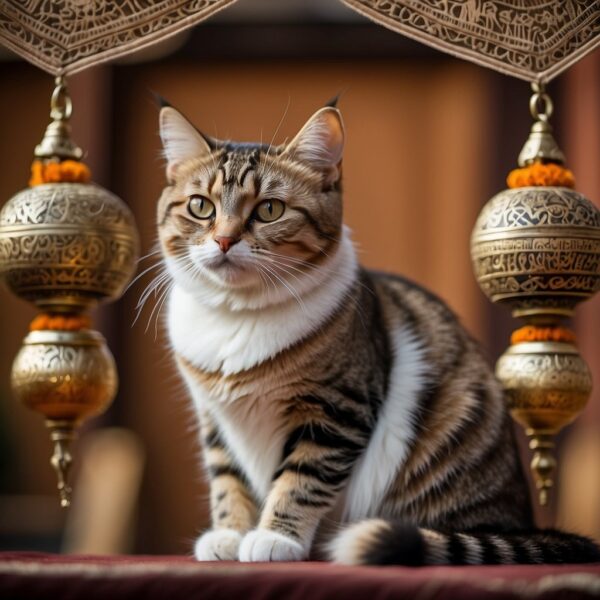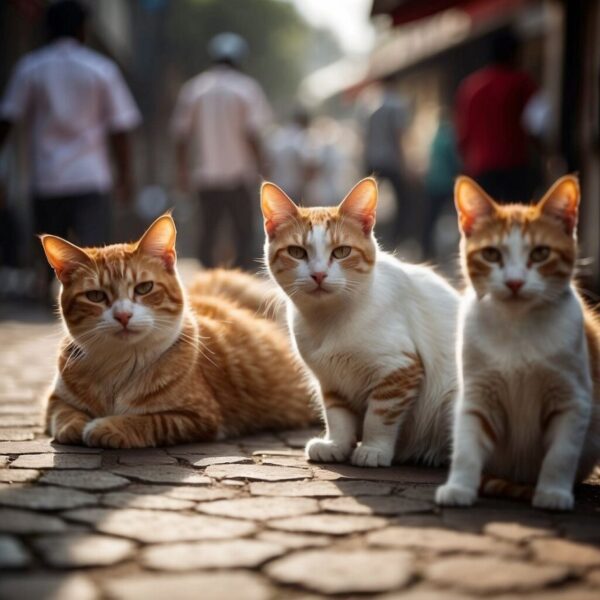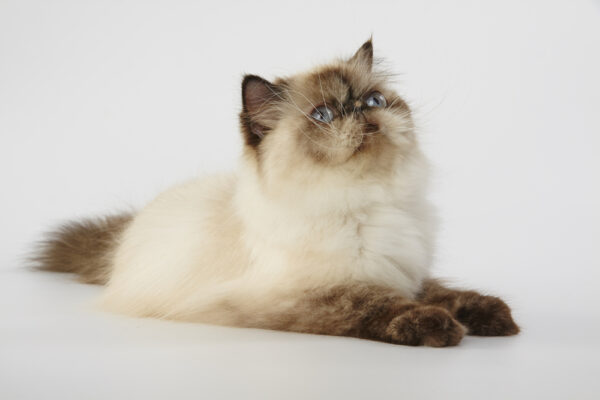
Cat Breeds Popular in India
Cats have been integral companions to humans for thousands of years, and this is no different in India, where a rich history has shaped a number of unique cat breeds. These Indian cat breeds offer a fascinating glimpse into the country’s cultural and biological diversity. Originating from different parts of the subcontinent, each breed presents a set of characteristics, behaviors, and appearances that reflect their adaptations to India’s varied environments and societies.
The history and origin of Indian cat breeds weave through a tapestry of folklore, tradition, and selective breeding practices. With India’s vast geographical diversity, from the Himalayas in the north to the tropical coasts in the south, Indian cats exhibit a variety of physical traits and temperaments suited to their regional habitats. Despite their distinctiveness, much like the lesser-known native dog breeds, Indian cat breeds have only recently begun to be appreciated for their genetic uniqueness and cultural significance.
Key Takeaways
- Indian cat breeds possess distinct characteristics shaped by India’s diverse environmental conditions and cultural heritage.
- The origin and history of these cats are deeply interconnected with Indian traditions and selective breeding over centuries.
- Recognition and appreciation for the uniqueness of Indian cat breeds have grown, highlighting their role in India’s biodiversity.
History and Origin of Indian Cat Breeds

Indian cat breeds boast a rich heritage interwoven with the country’s culture and history. These breeds have evolved over time, shaped by geographical isolation and human influence.
Ancient Roots and Cultural Significance
India has been a cradle for various domestic animals, and cats are no exception. The country’s long-standing connection with felines is evident in historical accounts and artifacts. One breed that has its roots in Indian history is the Indian Billi, a native domestic cat that has thrived in the Indian subcontinent for centuries. Often found in rural and urban settings alike, the Indian Billi is known for its robust health and adaptability to the Indian climate.
Indian cat breeds have been less documented compared to breeds from regions like Persia and Egypt, where cats like the Persian and the Egyptian Mau are well-documented. These breeds, with their distinct characteristics and pedigrees, have garnered worldwide fascination and have been extensively bred and shown.
Although not as internationally recognized as the Persian or the Egyptian Mau, Indian cat breeds hold cultural significance and are often featured in local folklore and mythology. They differ from the plush coats of Persian breeds and the spotted elegance of the Egyptian Mau, offering instead a diverse gene pool resulting from a less selective and more natural breeding process.
Moving toward the northwest, the influence from Turkey becomes apparent in various regional breeds. While there’s no direct reference linking Turkish cats to specific Indian breeds, both regions have a historic appreciation for cats, which is reflected in their respective cultural landscapes.
Cats from the Indian subcontinent have yet to make a significant mark on the global stage, unlike other breeds with origins in nearby regions. However, the diversity and unique characteristics of Indian breeds still represent a largely untapped genetic and cultural resource.
Popular Indian Cat Breeds
Indian cat breeds are as diverse as the country’s culture, ranging from the sleek Bombay Cat to the fluffy Himalayan. These breeds have unique traits and have garnered popularity among cat enthusiasts in India.

Bombay Cat
The Bombay Cat, not to be confused with the city, is an Indian breed known for its striking black coat and copper or yellow eyes. This breed is medium-sized with a muscular build, and its glossy black fur is its most distinctive feature.

Himalayan Cat
The Himalayan Cat is characterized by its long, luxurious coat and distinctive color points on its ears, face, paws, and tail. These cats have a sturdy body, large expressive eyes, and are among the most popular cat breeds in India.
Indian Domestic Cat
Indian Domestic Cats, commonly referred to as ‘Biladi’, vary widely in size, color, and temperament. They are well-adapted to the local environment, making them a common sight in Indian neighborhoods. Despite their mixed breed status, they are cherished for their resourcefulness and independence.

Characteristics of Indian Cat Breeds
Indian cat breeds possess distinct traits that set them apart, encompassing both their physical appearance and their behavioral patterns.
Physical Features
Indian cat breeds typically exhibit a sleek and elegant appearance. They often have a lean build with well-muscled legs which contribute to their agile movement. Many Indian breeds have a long tail that helps them balance, especially when climbing or making intricate movements. The coat of an Indian cat may vary, but it is not uncommon to find a whitish hue amongst these breeds, often with patches or other color variations.
- Appearance: Lean build, muscular legs, long tails.
- Coat: Often whitish, can have patches or mixed colors.
Temperament and Personality
These cats are known for their affectionate nature, forming strong bonds with their human companions. Indian cats are typically intelligent creatures, quick to learn and adapt to their environment. They have a balanced temperament that makes them suitable pets for various types of households. Playful yet gentle, these cats can be both active and content in serene environments.
- Affectionate: Strongly bond with owners.
- Intelligent: Learns and adapts quickly.
- Temperament: Playful, gentle, adaptable to different environments.
Health and Care
When it comes to Indian cat breeds, specific attention to grooming needs and awareness of common health issues are crucial for maintaining their well-being.
Grooming Needs
Indian cat breeds with longhair coats require regular grooming to prevent matting and to keep their fur in good condition. This should include brushing several times a week. It is also important to keep an eye on cats with denser fur as they are more susceptible to skin issues hidden beneath their coats.
Common Health Issues
Cats in India may encounter breed-specific health concerns, including eye conditions. Cat parents should be diligent with regular check-ups to monitor and address any potential eye issues as early as possible. Additionally, breed-specific predispositions to certain health problems should be discussed with a veterinarian to ensure proper care.
Breeding and Genetics
The breeding practices and genetics of Indian cat breeds have a significant impact on their health and diversity. The genetic diversity within breeds is crucial for maintaining a healthy and resilient population.
Genetic Diversity
Genetic diversity refers to the total number of genetic characteristics in the genetic makeup of a species. It is essential for the survival and adaptability of a species. In the context of Indian cat breeds, such as the Bombay and Himalayan, maintaining genetic diversity helps prevent genetic disorders and enhances the breed’s resilience to changes and diseases.
- Bombay: This breed was created by crossing black American Shorthairs with sable Burmese. The goal was to produce a cat with a sleek, black coat, resembling a miniature panther. Genetic diversity is maintained by careful breeding practices to avoid inbreeding-related health issues.
- Himalayan: Developed by cross-breeding Persians with Siamese to introduce the point coloration, the Himalayan shares genetic traits from both breeds. Breeders must monitor for the associated health problems in both Persians and Siamese, including respiratory and kidney issues.
- Persian Cat: Persians are known for their long, luxurious coats and distinct flat faces. The breed’s genetics often come with a predisposition to certain hereditary conditions like polycystic kidney disease; conscientious breeding practices are imperative to mitigate these issues.
Leopard cats, wild cats native to various parts of Asia including India, have contributed to the genetics of certain domesticated breeds through hybridization. The Bengal breed, for example, is a result of crossbreeding between domestic cats and leopard cats. This highlights the genetic diversity introduced by such hybrid cats, which can be seen in their distinctive coat patterns and robust health.
In summary, breeders of Indian cat breeds must pay careful attention to genetic diversity to ensure the health and vitality of these beloved animals. Conscientious breeding programs that prioritize genetic health can help sustain the rich heritage of these breeds for generations to come.

Cultural and Societal Impact
The relationship between cats and Indian society extends far beyond simple pet ownership, encompassing a multifaceted cultural significance as well as the integration of these animals within familial and societal structures. Domestic cats are often seen as members of the family and appreciated companions.
Cats in Indian Society
In India, cats have carved a unique niche in the societal framework. They predominantly assume the role of companions in Indian households, offering emotional support to family members. The affection and camaraderie provided by cats are valued aspects of the dynamic within Indian homes.
Making a place for themselves in diverse Indian climates, these felines have demonstrated remarkable adaptability. Whether it’s the dry heat of the Thar Desert or the humid tropics of Kerala, domestic cats have thrived, showcasing their resilience and becoming an integral part of local life patterns.
Furthermore, the domestic cat plays a dual role in India, not only as a companion animal but also as part of the ecological balance, often employed in rural and urban settings for pest control. This utilitarian aspect underlines the practicality of their presence in Indian society, creating a synergy where their companionship is as much valued as their utility.
Conservation and Habitat
India’s diverse landscapes serve as an important reservoir for both domestic and wild cat breeds. The need for conservation of these felines is paramount, particularly in the face of habitat degradation and human-wildlife conflict.
Wild Cats in India
Jungle Cat (Felis chaus): These medium-sized wild cats are adaptable creatures found across various habitats, including forests, wetlands, arid regions, and suburban areas where they may live unnoticed by humans. They primarily inhabit areas with dense vegetation which provides cover for hunting.
Rusty-Spotted Cat (Prionailurus rubiginosus): Considerably smaller than the jungle cat, the rusty-spotted cat is among the tiniest wild cats in the world. Its limited distribution is confined principally to India’s forested areas and grasslands, making conservation of its habitat crucial. This elusive feline is often found in the dense undergrowth and tall grasses that facilitate its stealthy movement.
Conservation Efforts: They focus on both protecting the wild cat’s natural habitats and managing human-cat conflicts. The overlap of domestic populations with these wild species is a particular concern and calls for more nuanced conservation strategies that address the distinct needs and challenges faced by each species. Farmlands and urban fringes often become scenes for such conflicts, and conservation strategies in these areas are essential in maintaining a stable balance between human activities and the needs of wild cat populations.
Frequently Asked Questions

This section addresses common inquiries regarding cat breeds native to India, with a focus on their characteristics, lifespan, popularity, temperament, behavior, and sourcing.
What are the most well-known cat breeds native to India?
The Indian subcontinent is home to several cat breeds, with the most renowned being the Bengal cat, known for its leopard-like markings, and the rustic-looking Indian Billi, which is a common domestic cat found across the country.
How do the appearances of popular Indian cat breeds differ?
Indian cat breeds exhibit a range of appearances. The Bengal cat boasts a striking spotted or marbled coat, while the Indian Billi often has a short-haired coat with various colors and patterns, including solids, tabbies, and bicolors.
What is the average lifespan of commonly found Indian cat breeds?
The lifespan of Indian cat breeds varies. The Bengal cat can live for 12 to 16 years, while domestic cats like the Indian Billi typically have a lifespan of around 12 to 14 years, depending on their health and living conditions.
Can you list the top cat breeds that are found in Indian homes?
In Indian homes, the Bengal cat is highly prized for its exotic appearance. The Indian Billi is also widely found due to its adaptability. Other popular breeds in India include the Persian and Siamese cats, known for their distinct features and personalities.
How do Indian cat breeds compare in temperament and behavior?
The Bengal cats are energetic, intelligent, and require stimulating environments to thrive. The Indian Billi is known for its hardy nature and tends to be agile, alert, and relatively independent, making it well-suited to the varied Indian climate and urban environment.
Where can I find reputable breeders or adoption centers for Indian cat breeds?
Reputable breeders for specific Indian cat breeds such as the Bengal can be found through registered clubs and feline associations, while adoption centers and animal shelters may have a variety of cats, including the Indian Billi, looking for homes. It is crucial to ensure the credibility of the breeder or center before making a commitment.